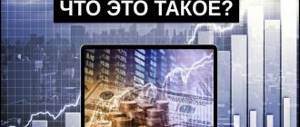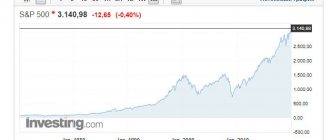Today’s publication will provide the reader with not only a decoding of the frequently encountered abbreviation “ ADR ”, but will also reveal the ins and outs of the financial instrument hidden underneath it.
Until now, we have mentioned ADRs (American Depositary Receipts) only in passing, without even trying to delve into their investment properties.
Today we will touch on some historical facts, get a basic idea of what ADRs are , and analyze the individual advantages that these securities provide to issuers and investors.
The Moscow Stock Exchange is a record holder for dividends
Types vary largely by the exchanges on which they are traded. The largest number of US Depositary Receipts, or ADRs, issued. In America, as in other countries, there is a ban on the import of shares of foreign companies. In order for a foreign entity to be listed on a U.S. exchange and be able to attract U.S. investors, it will be required to issue American Depositary Receipts.
The first issue of ADRs took place in 1927, when a chain of British department stores wanted to raise capital in the US market, but were unable to do so due to legislation. After the end of the Great Depression, the depositary receipt market gained momentum, but the brightest time was the period of the 90s, when American funds began to look for opportunities to invest in high-yielding stocks and bonds traded in emerging markets. To carry out everything strictly according to the law, the instrument in the form of depositary receipts worked.
There are over 2 thousand depository receipts in the USA, among which there are representatives of the Russian sector: Sberbank, Novatek, Rosneft, but most are represented on the over-the-counter market. If we talk about blue chips presented on the US stock exchange, we can mention MTS and Mechel.
What are ADRs and GDRs? All the most important things about depositary receipts
The legislation of most states prohibits the free circulation of securities of foreign companies, as well as the export of shares of domestic issuers. But how then can investors acquire a stake in non-resident global companies and build a global portfolio?
This problem was solved in the first half of the 20th century.
Then the UK introduced a ban on the withdrawal of national securities from the country. At the same time, the United States also vetoed the movement of shares of foreign companies. Americans wishing to purchase securities of an English company decided to create depositary receipts, which provide ownership of one or more shares (bonds) of a foreign issuer. In 1927, Morgan Guaranty Bank developed the first DRs on shares of the British department store chain Selfridges for trading on the New York Street Exchange (now the American Stock Exchange). More precisely, these receipts are called ADRs, that is, American Depositary Receipts (ADRs).
British management companies, eager to receive American dollars for their shares, also contributed greatly to the emergence of ADRs.
The development of the depositary receipts market was greatly slowed down by the Great Depression of 1929. However, over time, it began to expand, reaching its peak in the 90s. DRs also appeared in other countries - they were called global depositary receipts (Global Depositary Receipt - GDR).
There are also Russian (RDR), which appeared in 2010 for UC Rusal shares traded on the Hong Kong Stock Exchange, European (EDR), designed by Citibank in collaboration with the Paris Stock Exchange, Japanese Depository Receipts (JDR), developed by Mitsubishi UFJ Trust and Banking Corporation and Citibank.
Meanwhile, Russian legislation does not prohibit foreign companies from listing their shares on the stock exchange without RDR. For example, the St. Petersburg Stock Exchange presents shares of foreign companies, for example, Google, Amazon and others. And on the Moscow Exchange you can find shares of Russian companies registered abroad, for example, on the exchange there are also shares and RDR of Rusal.
Types of receipts
A depositary receipt (DR) is a secondary security that is freely traded on the stock market. It is issued by the depository bank in the form of a certificate, which certifies the right to own a certain number of shares (or bonds) of a foreign issuer.
Their history, as we have already noted, began with the creation of ADRs, which are divided into 5 types. There are unsponsored (unsponsored) and sponsored (sponsored) ADRs of four levels. Let's look at them in more detail.
Unsponsored programs are conducted by the custodian bank on shares that are already outstanding. In this case, the initiator of the issue can be either the depositary bank itself or a major shareholder.
When issuing depository receipts, there is no formal agreement between the depository bank and the issuer. The main advantage of these securities is that when they are issued, the US Securities and Exchange Commission (SEC) imposes minimum requirements for the provision of financial statements on the activities of the issuer of shares. The SEC requires only documents confirming full compliance of the activities of the issuing company and its securities (stocks and bonds) with the laws of the issuer’s country.
However, unsponsored ADRs are traded only on the Over-the-counter market (OTC) and are listed on the Pink sheets, a daily newsletter that publishes OTC market maker prices, or on the OTC Bulletin Board. . There is no access to official exchanges and the NASDAQ platform, which is the main disadvantage of such receipts.
Sponsored ADRs have become much more widespread because they allow a company to attract new capital. The initiator of the issue of sponsored receipts is the issuer himself, and they are issued both for outstanding securities and for new ones.
Let us highlight several main levels of sponsored ADR programs: first, second, third and according to rule 144A/REG S. The higher the level of depositary receipts, the stricter the requirements for the company to disclose information to foreign market participants.
ADR I (First Level ADR) , like unsponsored programs, requires compliance with minimum SEC requirements, including the company not being required to publish reports in accordance with US GAAP standards. Such receipts are issued for shares that are already in circulation. They are also characterized by low organization costs. ADRs of this level are traded on the over-the-counter market, their prices are published daily on the Pink Pages and Bulletin Board. Such ADRs serve to increase the liquidity of existing shares and their higher valuation.
ADR II (second-level ADRs) are also issued for already issued shares, but already require the issuer to submit reporting to the SEC according to American standards. However, in this regard, second level receipts can be traded on the NYSE, AMEX or on the NASDAQ market.
It is worth noting that second-level receipts are extremely rare, because the requirements of the Securities and Exchange Commission for the documents provided here are almost the same as at the third level. Therefore, from ADR I, companies often immediately switch to ADR III.
ADR III (third-level ADR) already allows the issuance of receipts for shares undergoing an initial public offering and pursues the goal of attracting new capital. This level is also called “public offering”. Here, the SEC applies the most comprehensive requirements for program registration and reporting in accordance with American standards to the issuer. The cost of implementing this program is the highest. Public Level III ADRs are listed on the NASDAQ system, NYSE and AMEX.
Finally, there are limited Rule 144A ADR programs , which provide the ability to issue receipts to a limited number of qualified investors for trading in the United States. This program is called a “private placement.” In this case, registration with the SEC is not required, and placement occurs in the PORTAL (Private Offerings, Resales and Trading through Automated Linkages) system.
This program allows you to receive additional financing by simplifying the procedures for providing information and registration, but at the same time limits the number of investors.
Regulation S (Reg S) provides that there are no direct sales of these securities in the United States. Such ADRs are intended for sale on the international market, and registration with the SEC is not required. Reg S is used in conjunction with Rule 144A.
Russian companies more often issue Level I ADRs, as well as under Rule 144A, since they report according to IFRS standards, which is unacceptable when listing on an American exchange. American legislation requires greater openness from companies, and issuers may be reluctant to disclose a large amount of information about themselves, owners, affiliates and other information.
Depository receipts are issued by depository banks. The largest issuers are Deutsche Bank, JPMorgan Chase, Bank of New York, and Citigroup. Let us examine in more detail the mechanism for issuing receipts.
Issue of depository receipts
The depository bank and custodian bank play a key role in the implementation of the DR issuance project. A depository agreement is concluded between the issuer of shares and the foreign depositary bank that issues receipts, which specifies the full name of the issuer, information about its location, postal address, the date of the decision on the issue and the name of the authorized body of the issuer of the DR that approved this decision, information on the name and location of the issuer of securities, their type, category (type), nominal value and other aspects.
In the country of the issuer, shares are deposited in a special custodian bank (custodian), with which the depositary bank has concluded a corresponding custodial agreement. These shares, held by the custodian bank, are collateral for the issuance of receipts by the custodian bank, which represent ownership of one or more shares of the issuer.
It is worth remembering that securities of foreign issuers certifying rights in relation to issue-grade securities of Russian issuers are placed in accordance with foreign law (and vice versa). Therefore, depositary receipts can be purchased by foreign investors in accordance with their own legislation, while agreements are largely regulated by the legislation of the issuer’s country.
The release can be viewed using the example of RDR in the diagram below.
Source: moex.com
Circulation of depositary receipts
After the issue and initial placement of depositary receipts are completed, the process of their circulation on the secondary market begins.
If an investor wants to buy depositary receipts of a foreign company, he gives an order to his broker. The broker has a choice: he either buys existing receipts or obliges the depositary to issue new ones. A broker purchases securities either through its branches operating in the country of the issuing company, or through brokers operating in the issuer's stock market.
A broker operating in the stock market of the issuing company's country buys the securities of that company, which must subsequently be deposited with the custodian bank. The custodian bank writes these securities to the account of the depository bank, which issues the depositary receipt, and through a special clearing house (for example, the Depository Trust Company) are delivered to the broker. The purchase process ends with the broker delivering ADRs to the investor or crediting his account.
If ADRs are purchased from another owner, they are simply transferred from his account to the buyer’s account.
Selling ADRs is the reverse process. An investor who decides to sell shares contacts his broker. Here again, the broker has two options: he either sells to another investor, or sells to a broker operating in the issuer's market the underlying stock receipts. When the shares deposited under the ADR are sold, the broker notifies the depositary bank, which redeems the receipts and notifies the custodian bank of the redemption. The custodial bank will re-register the shares to the new owner.
Conclusion
Depository receipts are a mutually beneficial tool for both domestic companies and foreign investors wishing to acquire a stake in a foreign company.
For issuers, this is an additional source of attracting foreign capital. They provide an opportunity to enter the international market, expanding the circle of potential investors, liquidity, share price, and also earn a reputation.
For investors, depositary receipts provide an opportunity to diversify their portfolio, as well as receive dividends and vote. That is, in essence, they have all the advantages of shares. In addition, the transaction on depositary receipts is carried out according to the laws of the investor’s country, so there are no special difficulties in acquiring them.
More importantly, investors will be able to benefit from higher-yield and riskier investments, but without the added risks of moving directly to foreign markets, which could lead to a lack of transparency or instability as a result of changing regulatory procedures.
GDRs and ADRs of Russian companies are mostly traded on European exchanges, for example, LSE, some are represented in the USA on the NYSE and NASDAQ. Below is a reminder about depositary receipts of foreign companies traded on these exchanges. It is worth considering that some of the securities presented may also be traded on German exchanges, as well as over-the-counter markets. For example, Lukoil receipts are presented on the stock exchanges of London, Berlin, Stuttgart, Munich, and the US over-the-counter market.
open an account
BCS Broker
Transfer of shares to receipts
For clarity, let’s consider the situation that the domestic organization MTS intends to operate on US exchanges. The company immediately finds a custodian bank or custodian bank. The bank prepares the necessary documents and sends them to the Securities Commission, asking whether MTS can be counted on to work in the US market. The commission checks the documents and agrees to placement.
Most often, large financial firms are represented as custodian banks. This banking organization finds a depositary bank, which is located in the United States. The depository gives the green light to issue depositary receipts and conducts a PR campaign aimed at new clients. After this, the depository tells the custodian bank that a certain number of shares are needed. Custodian bank buys the required number of shares from the market and reserves them for itself. Secured by the shares held in the custodian bank, the depositary bank issues depositary receipts. Through a chain of intermediaries it is released into the US market.
What is an ADR (American Depositary Receipt)?
For more than thirty years, since the filing of the United States Securities Commission, American Depositary Receipts (ADRs) have been commonly understood as a certificate issued by a depository bank registered in the United States, granting its owner ownership of a certain number of foreign shares deposited by this bank (in relation to the United States). ) private corporations.
The mechanism of action of ADR is hidden in this definition.
ADRs are issued by the most reputable banks in the United States: Bank of New York, JP Morgan Chase, Citibank and others.
This sets a high level of trust in the securities being issued.
Before issuing ADRs, listed banks purchase securities of foreign companies and deposit them in their accounts.
By selling ADRs to investors in the future, such depository banks actually sell them the securities at their disposal.
In other words, by buying ADRs, a US investor is actually buying foreign shares.
In this process, the bank acts as an intermediary between the foreign corporation and the American investor.
As the owner of an ADR, an investor has the right to count on receiving dividends from the ownership of shares, which is certified by the corresponding American Depositary Receipt, as well as the opportunity to earn money from changes in the market value of the ADR.
Types of ARD: 4 levels
Initially, ARD can be divided into:
- sponsored - transactions are carried out manually, in closed electronic systems, this option is not interesting to us;
- unsponsored.
The first type, or sponsored ones, are divided into 4 levels depending on the degree of difficulty. Let's look at each of them in more detail.
Level 1 – ADRs on the US OTC
The lowest requirements are put forward for this market, as a result of which most of the ADRs of domestic companies belong to this level and are available here. Moreover, shares may be available on EU markets. This must be remembered in the process of analyzing quotes.
Level 2 – turnover of receipts in the US market
These instruments are subject to more stringent requirements. Moreover, shares must be approved by the Central Bank Commission and stock exchanges. In addition, approval is required from the stock platform. If we talk about examples of domestic companies, here are MTS and Mechel.
Level 3
These are receipts for re-imitation shares registered in the United States.
Level 4 - action under rules 144A
Access is open exclusively to large, influential US institutional investors who invest a minimum of $100 million in assets. Most often these are receipts that are presented at levels 1 and 2.
ADR
The main objective of ADR is to bring the delivery of dangerous goods to a single standard and increase the safety of road transport, which would allow the unhindered transit of hazardous substances through the countries participating in the agreement.
The agreement was supported by several countries that are not members of the European Community. ADR includes the agreement itself and contains 2 annexes:
Adj. A – General definitions and provisions relating to dangerous goods;
Adj. B – Definitions applicable to transport equipment and transport operations.
These additions are periodically reviewed by the international working group WP17 WP18 at meetings once every couple of years, approved and published. Version of ADR 2021 2021 is valid from O1.O1.19 and will be applied until 3O.O6.21. From 01/01/2021, the new edition of ADR 2021 will be valid.
When transporting hazardous materials, situations are possible when ADR requirements are not relevant, and, therefore, compliance with ADR standards in terms of markings and danger signs, packaging and documentation is not necessary.
The principles of ADR 2021 2021 are not valid for transport:
— vehicles with a maximum speed of less than 40 km per hour;
— vehicles of the Russian Army;
— private traders of goods with danger for their own needs in retail packaging;
— flammable liquids in containers (canisters) for repeated use with a volume of up to 60 liters. in total no more than 24 O liters per car;
— mechanical units, the equipment of which contains hazardous substances;
— hazardous substances that are formed as secondary products during the main production process of the organization,
— hazardous substances by rescue and emergency response services;
— gaseous substances inside car tanks;
— gaseous substances of groups A and O at a pressure of no more than 2 bar and t=20 C;
— gaseous substances in vehicle installations;
— fuel in tanks is no more than 15OO liters. for one vehicle;\
— fuel in the tanks of transported vehicles and units;
— empty, uncleaned containers from under goods II, III, 4.1, 5.1, 6.1, VIII, IX.
However, it should not be forgotten that there are a number of hazardous substances that have been excluded from the ADR list.
Why do we need company depositary receipts?
Everything here is extremely simple and transparent. For clarity, let's consider the situation. So, a domestic organization entered the US stock exchange and received a large number of mentions in newspapers and popular print media, this allowed it to improve its reputation. Thanks to such processes and work with large banks in other countries, reporting is confirmed by US regulatory firms. But, in reality, the situation is such that the company exclusively issues receipts on the US stock exchange; quotes even on the Moscow Exchange will increase, based on the improvement of the reputation and reliability of the organization itself.
The advantage in this situation can also be seen in the fact that the company, by entering a foreign site, opens up access to additional investments from abroad. As you know, big money circulates on US exchanges, and the company’s shares become liquid.
Why does a foreign investor need to purchase depository receipts?
For clarity, let’s imagine the situation that you are a farmer in America and are aiming to purchase shares of the MTS company. First, try to open an account with a Russian broker to buy shares. The situation and the process itself will be complex, so it’s easier to find a domestic company and enter the stock exchange on your own. Then purchase receipts for the selected asset, based on the legislation in the country and the nuances regarding local laws.
Moreover, in this case, the farmer can replenish his portfolio with a receipt for shares of companies that are represented in the markets of developing countries. Such assets have good growth potential and are able to provide excellent dividend yields than US companies. In this case, the investor can receive payments on a receipt, and even immediately in the national currency - dollars.









